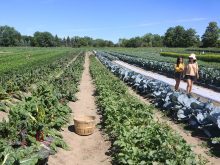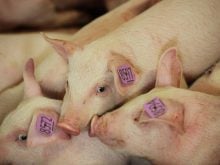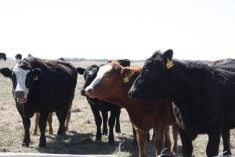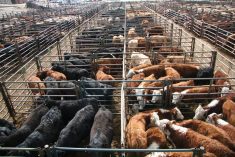CLARESHOLM, Alta. — Cattle producers shouldn’t rush into their hay purchases this winter.
Forage specialist Tracy Dow told a cow nutrition seminar in Claresholm that there are a number of things to consider when buying hay.
“You need to ask yourself if you are going to be in a supplementing position or substituting position,” he said.
Inventory checks are necessary to see how much more feed is needed. If considering substitutions, remember that each feed provides different levels of nutrients.
Cereal straw is a good alternative, with oat straw being the best. However, Dow said it is low in all nutrients, which means cattle have to be supplemented with extra vitamins and minerals.
Read Also

Canada told trade crisis solutions in its hands
Canadians and Canadian exporters need to accept that the old rules of trade are over, and open access to the U.S. market may also be over, says the chief financial correspondent for CTV News.
Pulse rejects, canola screenings and malt sprouts are also good alternatives, but should be introduced slowly so cattle’s digestive systems can adjust.
Overall, demand for feed in southern Alberta is strong because of last year’s drought. Most hay is coming from central and northern Alberta and Saskatchewan.
Dow said it is important for buyers and sellers to speak the same language in terms of weight and quality.
Export hay is sold in metric measures but domestic hay is often sold in imperial measures. If a buyer thinks he is getting a metric tonne but the seller means an imperial ton, the result is 10 percent less hay than expected.
Hay comes in different types of bales. Small square bales require more handling but are preferred by some.
The large round bales come with a hard or soft core. There is tremendous variation in weight and size. As well, they are expensive to ship — $4 per loaded mile.
New big square bales are bulky, but can offer a better payload. They are easier to haul, less bulky than round ones and are dense, which means more forage.
Same language
Buyers and sellers should also share the same definition of quality, which requires a feed test covering visual and chemical analysis.
Hay harvested in central and northern Alberta last year may be weather damaged and over mature, with lots of coarse stems.
Some stands were cut late and other crops were left in windrows too long because of excessive rain. It is high in fibre but low in energy because the carbohydrates and sugars leached out.
A considerable amount was baled at a high moisture content, which increased spoilage.
A visual appraisal may require rolling out the bale to check for mould and heat damage. Look at the end of the bale for leaf retention.
A coring device is another test option. A hollow 2.5 centimetre diameter metal rod is pushed into the bale to draw out a core sample of hay for visual and chemical testing.
Chemical feed analysis provides valuable nutrient information. Costs are based on how much information is requested.
The basic test measures moisture content, crude protein and the presence of minerals like calcium, phosphorus, potassium and manganese. Acid detergent fibre is also measured. It is the energy content as opposed to neutral detergent fibre, which is the voluntary intake.
A more detailed and expensive test looks at the relative feed value. This is a numerical comparison for forage quality.
Another test determines the presence of nitrates that may have been formed due to heat damage. Nitrates can be toxic if consumed in large amounts.
Dow recommends taking 20 different core samples at random from a number of bales. Freeze them in a sealed plastic bag and send to the lab as soon as possible.
During years like this when hay is in short supply, two year-old hay is still good if it was stored properly.
The outer 7.5 cm of the bale, which makes up 20 percent of it, can be destroyed if it was stored outside without protection.
Older hay holds the energy and protein content, but the vitamins and minerals have dissipated by this time so cattle will require supplements.

















